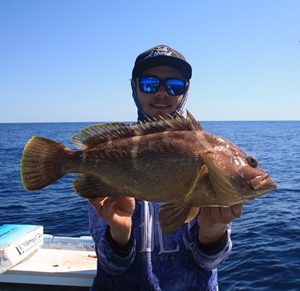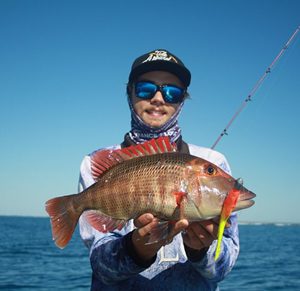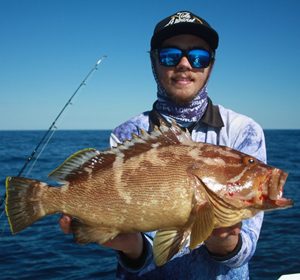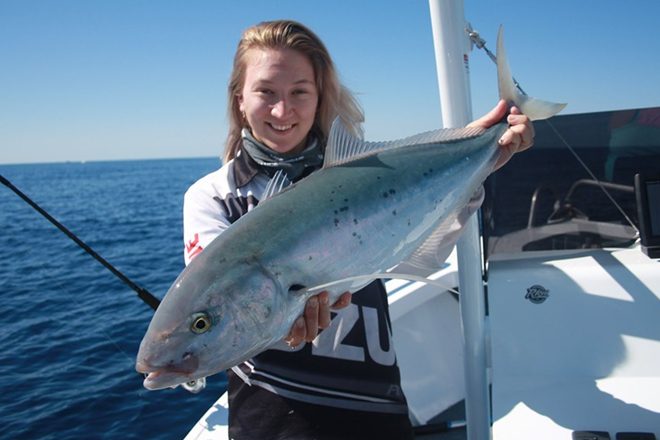


NOTHING beats the feeling of finishing the working week with big plans of heading out on the water over the weekend.
There’s generally only one type of person who will leap out of bed at a ridiculous hour of the morning while most sane people are sleeping, and that’s fishers. So with around an hour and a half of driving ahead of us on a recent Saturday fishing mission, we eagerly leapt out of bed at 3am making our way to the town of 1770.
Situated in an ideal location to access the pristine waters of the Southern Great Barrier Reef, 1770 is becoming an increasingly popular launching point and for good reason with world-class fishing at its doorstep. We arrived and launched just on first light and like most offshore trips for me we made our way straight to the bait grounds to stock the live bait tank with fresh slimies to later send down to some deep-water brutes.
After a successful half an hour on the bait jigs, we continued our journey out past the island groups to our destination of the deep dark depths outside of the Bunker Group reefs. Upon arrival, we were quick to deploy our first baits to the reef around 60m below us and it didn’t take long to get a fish on board. First to come over the side was a nice sized maori cod followed by a number of hussar.
We were fishing right on the turn of high tide, so at this stage we were fishing light with size 10 ball sinkers rigged with snelled 8/0 hooks. After around an hour of fishing in this area producing a couple of nice table fish, we headed further out into the deeper water where it didn’t take long to find a very good-looking rise on the sounder in around 100m of water.
We made our first drops only to realise the tidal current was now picking up, so it was time to up-size our sinkers to size 12’s but being a very isolated reef in that depth it was proving difficult to fish the reef successfully. The sounder was lit up with structure and fish so I wasn’t going to let the current beat us.
It can be a difficult balance as skipper when fishing isolated reefs in deep water as you must position the boat perfectly up-wind and up-current and make the call in the precise time to land you and your crew’s baits and lures on the reef to give the best chances of hook-ups. To add to the difficulties as skipper you must also ensure what you’re sending down will do the job when it comes to the fish in relation to your baits and lures and the weights used to get them down.
There can be a fine line when fishing in deep water where bottom time and a natural bait or lure presentation work hand in hand. If you put this out of balance using too heavy or too light of a rig, it can cause your bait or lure to look unnatural or just ineffective therefore not producing the bites. Anyone who’s fished deep water without the aid of electric reels will know that reeling back up is one hell of a workout, so you best make the drop worth it.
When bait fishing and lure fishing, I always start light and work my way up to a point where it’s a happy medium of getting you to the bottom and staying on the bottom with your bait or lure looking natural. Dropping down an unnecessarily heavy bait or lure will cause it to thump the bottom and have a tendency to get snagged, not to mention giving it characteristics of something a fish wouldn’t normally eat.
Fishing too light however will have you with very brief bottom time, minimising your chances of gaining the interest of the predatory fish you’re targeting. On this particular occasion we had our baits and lures doing the job, with plenty of fish coming over the side until unfortunately the toothy tax men arrived to make our hard work a waste of energy.
As you know, no fancy tackle can get past sharks and you can only move on and hope you don’t have to pay your taxes on the next reef. After a long day battling the big tides, we still managed a good mixed bag with some line burning sports fish adding to the excitement.
Quality fish were landed through adjusting our weights to suit the conditions, so never be afraid to experiment and discover what works best.
 Bush ‘n Beach Fishing Magazine Location reports & tips for fishing, boating, camping, kayaking, 4WDing in Queensland and Northern NSW
Bush ‘n Beach Fishing Magazine Location reports & tips for fishing, boating, camping, kayaking, 4WDing in Queensland and Northern NSW









